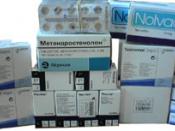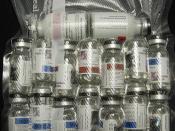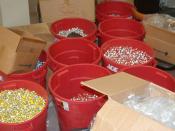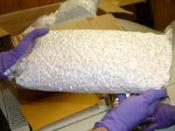September 15, 2009AbstractThe emerging use of drugs and steroids during the first 70 years of the 20th century warned of greater problems to come. Over the next few decades, from roughly 1970 to current, drug use in sports, particularly anabolic steroids would spread to such an extent that some would call it an epidemic. It is estimated that steroid users exceeded 3 million, and spending on steroids sold in the black market exceeded four million dollars. Other performance-enhancing drugs also grew during this time. While improved testing would eliminate reliance on many stimulants and barbiturates commonly used in the past, new forms of doping still continue to give some athletes and edge in competition. What's worse is that the problem is spreading through the nation's high schools and could be a real challenge to administrators of high school sports.
In today's society especially among teenagers doping has become known as a quick solution in achieving strength, size, and stamina.
The drug of choice is anabolic steroids. While testicular tissue was consumed and transplants were performed by surgeons internationally, the biochemistry of testosterone did not allow an incorporation into normal human physiology with resultant benefits until the molecule was synthesized in the laboratory. While it had been known since ancient times that castration of the male resulted not only in infertility but also in a loss of secondary male sex traits, several human physiology discoveries were necessary to develop our understanding of the function of testosterone and related molecules. In 1989 A.A. Berthold performed experiments in roosters that proved that the testes liberated a substance into the bloodstream leading to the development of roosters' sexual characteristics, including the formation of the comb and wattle (www.usrf.org/news/000908-origins.html). This discovery led to the ultimate understanding of endocrinology, in which hormones are liberated into the bloodstream and cause their effects without nervous system intervention (McCloskey and Bailes, page 83).
During the first decade of the twentieth century, rapid development preceded our understanding of male reproductive physiology. This ultimately brought about the extraction and isolation of androsterone, which not only stimulated the capon comb but also was found in the urine of human males. Experiments across species recognized the substance isolated from the testes (testosterone) was the more active substance and was transformed in the body to several other related steroid compounds (Bahrke, page 111). Surprisingly testosterone can be converted into approximately 700 similar compounds. These are all variations in the ringed chemical structure of cholesterol. In May of 1935 testosterone had been chemically isolated and synthetically made in the laboratory. There is a complex biochemical capability within the human body to convert testosterone through tissue enzymes, into hundreds of other molecules, including estrogen (McCloskey and Bailes, page 84).
Anabolic steroids are typically used by a couple of general classes of athletes. The first and most popular use is by individuals who desire to be stronger with greater capacity for strength, lean body mass, and speed (a lot of high school athletes desire this). When mixed with weight lifting, these athletes often achieve strength as well as weight gain with an average 5-pound increase in body weight after approximately 15 days of high dose steroid intake. (McCloskey and Bailes, page 84). This is directly caused by a greater accumulation of protein, muscle function and size. These steroids (anabolic) are suggested to be preventing the catabolic effects of glucocorticoid that are suppose to be released while an athlete is involved in intense physical training periods. This makes it possible for athletes to train more intensely and for longer periods throughout the day (McCloskey and Bailes, page 85). They also are believed to increase the number of oxygen-enriched red blood cells in the body, an obvious plus for any serious athlete, especially those involved with endurance and strength activities such as soccer, football, running and swimming. Anabolic steroids can benefit many more individuals besides those that just participate in strength related sports. Anabolic steroids can improve overall performance for those that participate in extreme intense and pro-long duration of training and competition (McCloskey and Bailes, page 85). In addition, there are other users who consume anabolic steroids for perceived positive effect on their appearance. The combination of steroid use and continued, simultaneous, intensive weight training, especially in experienced or pre-trained individuals results in drastic increases in muscle size, strength, and body weight (McCloskey and Bailes, page 90). The long term effects, and particularly the physiological permanent changes, the retention of prior gains, as well as the physiological effect on females and their athletic performance, have been inconclusively debated for decades and probably always will. While the number of serious adverse or fatal events with steroids has been low, the permanent or serious health effects are also uncertain (McCloskey and Bailes, page 90). Areas of concern are the effects of the long term steroid use upon the heart, liver, serum lipids, reproductive function in males, atherosclerosis, the immune system, and the psyche (McCloskey and Bailes, page 90). The systematic administration of anabolic steroids to Olympic athletes in the German Democratic Republic is the most popular example of state sponsored pharmaceutical competition. The exposed files, containing the highly sophisticated and rampant use of testosterone and its derivatives in both males and females, led to trials and punishment for many of the principals (McCloskey and Bailes, page 91). This sad saga, including the instances of liver and heart disease and the masculinization of many young girls, is detailed by Steven Ungerleider in his 2001 book Faust's Gold.
The federal government and nearly all states have legislation that controls the manufacture, distribution, and possession of anabolic steroids and other performance enhancing drugs. In addition, the prescribing of anabolic steroids is also legally controlled. The Federal Food, Drug, and Cosmetic Act (FEDCA) were amended in conjunction with the Anti-Drug Abuse Act of 1988 to stipulate that the possession or distribution of anabolic steroids with the intent to distribute or sale without a valid prescription would be classified as a felony. The Anabolic Steroids Control Act was passed in 1990, which made anabolic steroids a Schedule III drug of the Controlled Substances Act under the auspices of the Drug Enforcement Administration (DEA), which controls the manufacture, distribution prescription dispensing, and movement of steroid medications manufactured in and exported from the United States. The majority of anabolic steroids used in the United States are illegally imported, primarily from Mexico, while other European countries, particularly in Eastern Europe, have also been found as major steroid suppliers (Duncan, page 23). In addition, the potency, purity, and consistency of anabolic steroids available on the black market are believed to be the primary source supply for a large number of teenagers in America.
Statistics can and often due vary but the latest national survey of steroid use among American teen's reports that around 3 and a half percent of high school seniors admitted to using steroids at least once during their high school sport careers. This stat may not catch your attention at first, but it's a 66 percent increase over the 1991 report and a 18 percent leap over numbers cited by the National Institute on Drug Abuse in 1999 (http://www.msnbc.msn.com/id/4546250/ns/sports-other_sports/page/2/ ). Just because these numbers may appear misleading and tinny, they're rising very fast, and that's an indication of an American public education system that would rather expose reasons why it can't or won't do anything about it than find ways to prevent it.
The Olympics have tests for steroids and every other performance-enhancing drug you can think of. Pro sports leagues are testing more and more. Even colleges test for steroids. High schools, with just a few known exceptions, do not test. If we don't have a program that test for steroids, you are telling kids to go ahead and use them, because they won't get caught because no one is looking or even wants to know if their high school sport stars are doping. You can preach to teens repeatedly about the dangers and risk of taking steroids, about the incredible shrinking testicles and acne scares and possible liver damage they may experience down the road. There will always be some, just as there are some athletes at every stage of competition, who are willing to take the risks if they can see a clear reward (http://www.msnbc.msn.com/id/4546250/ns/sports-other_sports/page/2/).
We all know that Major League Baseball is caught-up in a public relations nightmare because, until recently, it didn't have a single test for any drugs, especially steroids. Because no one tested the players, no one knows for sure how many used performance enhancing drugs as well as human growth hormone to get larger and stronger. Stats were broken. Little kids and fans watched. And they all want to imitate and be like their heroes.
The Associated Press did a cover story report not long ago on kids that took steroids it stated "various high-school officials giving what is know as the standard excuse: They can't afford the $50 it costs for each steroid test. For other school systems, including those in New York and New Jersey, civil rights are cited by the few administrators who will even talk on the record about the subject". But in the same AP report (http://www.msnbc.msn.com/id/4546250/ns/sports-other_sports/page/2/ ), High schools that rather not test for steroids often test their athletes for party drugs like acid, cocaine and marijuana. To test for these party drugs are supposedly cheaper then testing for steroids. However, if performance enhancing drugs are not being tested for, they are just trying to satisfy the public by claiming they are testing school athletes for drugs. Who cares that they are testing them for party drugs? They should be testing them for drugs that are considered cheating and a violation of the game such as steroids! The numbers of teens taking steroids will continue to increase until performance enhancing test are administered. Mainly because the teens see such a large gain because they are not scared of getting caught.
Become a hero and you will receive a new car of your choice. All sport heroes are idolized for being big, strong, fast and skilled. We purchase equipment, clothes and an assortment of other products they endorse. Teens even dress like them, act like they do, and some even try to speak as they do. This wasn't invented by the media either; Greeks were known to celebrate athletes and warriors and were obsessed with those that displayed the physical appearance that many of us wish we could have. Being victorious during the ancient Greek Olympics secured your future for life, just as it can for athletes of today. Thousands of hours of video games are played that endorse pro athletes, magazine columns and large sections of our newspapers and cable networks and radio stations of all kinds are devoted to capturing their every move. In return they are rewarded by million dollar contracts so they can live like ancient Greek heroes. Except that these heroes owe allegiance and loyalty to no one at all.
What teenager wouldn't love to have a career like that? What aspiring athlete with a competitive nature and above-average coordination wouldn't want to get all of that? Especially if it means they get a chance to play a contest in front of millions. Most of us played some kind of sport as a kid and stood in the driveway or backyard and shot free throws. I'm sure some even pretended to be playing in some kind of championship game with the entire world watching on TV, all the pretty girls rooting for you in the stands. You made up a score that allowed you the opportunity to when the game on the foul line with no time left. The first shot tied the game and your second shot won the game for your team and they carried you off the court as you became their new hero. Now you start thinking of all the teams that are going to want you in the NBA draft and the fancy houses you are going to buy for yourself and your entire family, not to mention all the toys you ever dreamed about such as a candy apple red Ferrari, jet skies, boat and all the trips to Vegas you want. After all, in your dreams, you will be able to afforded it because of the $100,000,000 contract you were awarded to play in the NBA.
For most of us we soon realize we will probably never gain the skill that is required to fulfill our childhood fantasy's of becoming a pro athlete. However, the select few that do show the skills, latch onto it and begin devoting their every waking minute to fulfilling their dreams and receive mentoring on the correct way of doing things. However, the teens that believe they may be on the edge somewhere between going pro or having to hang it up may become desperate and try anything to hang onto these dreams. Four decades ago, those that wanted to get bigger spent hours every day going to the weight room to workout. Next their diet became an issue, followed by advanced types of performance training. NFL locker rooms 25 years ago often looked like a Mr. Universe competition. You had to have muscles to be in the club. It's a different world today in the NFL. You don't see the 300-pound guys with 2 percent body fat like we use to see. You get caught doing steroids; it's a four-game suspension for the first offense. It's not worth it especially when you have so many others looking to take your spot.
However, many teens entertain the notation that it is worth the risk while in high school; mainly because they know the risk of getting caught is low. The benefits of being one of the select few to go on to college and the big leagues are too tempting. Teens who feel immortal are in no way shaken by what may happen to their bodies' years down the road. Some national program needs to be put in place that requires testing for steroids and other performance enhancing drugs. Especially for high school athletes because it is here the numbers are the greatest. It shouldn't be left up to the local education systems. The state and federal government needs to get involved so they can counter any school's reason for not testing due to lack of funds. We need to keep our sporting events clean, fair and safe. The only way to do this is by finding a way to conduct the test instead of the reasons why we can't.
Appenzeller, H. and Appenzeller T. (2008). Successful Sport Management 3rd Edition. Durham, North Carolina: Carolina Academic Press (2008).
Blumenthal, K. (2005). Let Me Play. New York, New York: Simon & Schuster (2005).
Duncan, J. (2004). From Ali to X-Games: Sport in American Culture. Santa Barbara, California: Santa Barbara Press (2004).
Yesalis, C. E. & Bahrke, M. S. (2002) History of doping in sport: Performance-Enhancing Substances in Sport and Exercise, Champaign, Illinois: Human Kinetics Publishers.
Yesalis, C. E. & Courson, S. P. (2000) History of anabolic steroid use in sport and exercise: Anabolic Steroids in Sport and Exercise, 2nd edition, Champaign, Illinois: Human Kinetics Publishers.
Bahrke, M.S. Yesalis, C. E. (1995) Anabolic-androgenic steroids: Performance-Enhancing Substances in Sport and Exercise, Champaign, Illinois: Human Kinetics Publishers.
Friedl, K. E. & Yesalis, C. E. (2000) Effect of anabolic steroid use on body composition and physical performance, Champaign, Illinois: Human Kinetics Publishers.
Ungerleider, S. (2001) Faust's Gold, New York: Thomas Dunne Books/St. Martin's Press.
Kammerer, R. C. (2002) Drug Testing in Sport and Exercise, Champaign, Illinois: Human Kinetics PublishersMcCloskey, J. & Bailes, J. (2005) When Winning Costs Too Much: Steroids, Supplements, and Scandal in Today's Sports, Lanham, Maryland: Taylor Trade PublishingUrological Sciences Research Foundation: Origins of Testosterone Replacement, Retrieved September 5, 2009 from http://www.usrf.org/news/000908-orgins.html.
NBC Sports: Time for Steroid Testing in High Schools, Retrieved September 5, 2009, fromhttp://www.msnbc.msn.com/id/4546250/ns/sports-other_sports/page/2/Suggs, W. (2005). A Place On The Team. Princeton, New Jersey: Princeton University Press (2005).
Koehler, M. & Giebel, N. (1997) Athletic Director's Survival Guide: New Jersey: Prentice Hall (1997).




